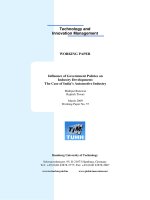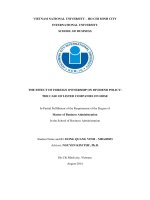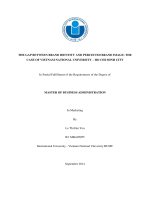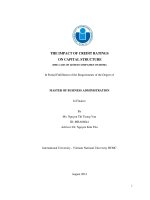EMPIRICAL STUDIES ON PUBLIC DEBT THE CASE OF VIETNAM
Bạn đang xem bản rút gọn của tài liệu. Xem và tải ngay bản đầy đủ của tài liệu tại đây (5.1 MB, 124 trang )
Kobe University Repository : Thesis
学位論文題目
Title
EMPIRICAL STUDIES ON PUBLIC DEBT: THE CASE OF VIETNAM(政府
債務についての実証分析―ベトナムの場合)
氏名
Author
Nguyen Thi Ngoc Anh
専攻分野
Degree
博士(経済学)
学位授与の日付
Date of Degree
2017-03-25
公開日
Date of Publication
2018-03-01
資源タイプ
Resource Type
Thesis or Dissertation / 学位論文
報告番号
Report Number
甲第6957号
権利
Rights
JaLCDOI
URL
/>
※当コンテンツは神戸大学の学術成果です。無断複製・不正使用等を禁じます。著作権法で認められている範囲内で、適切にご利用ください。
Create Date: 2018-09-19
Submitted Date: December 19, 2016
Title: EMPIRICAL STUDIES ON PUBLIC DEBT: THE CASE OF VIETNAM
“
-
“
Graduate School of International Cooperation Studies
Department of Economic Development and Policies
Academic Adviser: Professor Seiichi FUJITA
Student No. 114i801i
Name: NGUYEN Thi Ngoc Anh
ACKNOWLEDGEMENTS
I would like to thank my supervisor, Professor Seiichi Fujita, for the understanding,
patient guidance and advice. His expertise has helped me to broaden my knowledge to
complete my research.
I would also like to thank Professor Koji Kawabata and Professor Masahiro Kodama
for giving me better understanding about econometrics and for their critical comments
in developing appropriate models for the case of Vietnam.
I would also like to thank my friends at Kobe University, Dinh Ngoc Quynh and Bui
Thi Hong Nhung, for their friendship and the helpful discussion about my research.
Furthermore, I would like to thank all members of GSICS Academic Affairs Office,
especially Ms Kika KONISHI, for their help and support.
Finally, I would like to thank my family, especially my parents, my husband and my
lovely daughter, who encourage me and support me any time.
Nguyen Thi Ngoc Anh
December 19, 2016
i
EXECUTIVE SUMMARY
The dissertation aims to study the effects of government debt on the solvency
risk, economic instability and the quality of banks’ loans in case of Vietnam by
empirically testing the three main hypotheses following from the theoretical analysis:
1)
An increase in domestic borrowing causes Vietnam to be more prone
to external shocks (as measured by CDS spreads).
2)
Greater reliance on domestic debt as compared to external borrowing
leads to a higher economic instability in Vietnam.
3)
Higher the country’s overall public debt is associated with higher
level of non-performing loans in local banks.
The economy of Vietnam is now under severe pressure and threatened by
aggressive level of risk related to large public debt - driven mainly by the expansion of
domestic borrowing, serious fiscal challenges, inflation uncertainty and huge amount of
bank’s non-performing loans. This has made it paramount to empirically investigate the
relationship and impact between government debt, country credit risk, inflation and
bank’s non-performing loans so that the policy makers will be well informed in
identifying and framing the problems of both macroeconomic conditions and financial
market and then can effectively make decision on both fiscal and monetary policy. In
addition to that, the government of Vietnam has been also warned, without empirical
evidence, that high public debt and in more specific, greater reliance on domestic debt
with higher interest rate and shorter maturity can be a serious obstacle to fiscal
improvement, development performance and economic growth of Vietnam.
So far, there has been no empirical evidence on the effects of domestic debt on
both financial and macroeconomic conditions in the context of Vietnam. Much of the
existing studies have focused mainly on external debt in the context of industrialized
countries, while the issue of internal debt has received less attention. This study, hence,
ii
contributes to the existing literature by empirically testing the impact of government
debt; with specific concentrate on the domestic debt effects, on Vietnam’s economic
performance in general and on banking market risk in particular, using different
economic models such as Autoregressive Distributed Lag Modeling, Vector Error
Correction Model and one-step System GMM estimation.
This dissertation includes five chapters – the first chapter provides a general
introduction of public debt situation in Vietnam, the next two chapters empirically
examine the impact of government debt on macroeconomic variables, with particular
concentration on domestic debt analysis due to its increasing contribution to the
country’s overall public debt, fourth chapter will be more detail in accessing the effect
of Vietnam’s public debt on banking market risk and final chapter will be the
concluding remarks. Specifically:
Chapter 1 is a brief introduction. For systematization purposes, the current issue
of Vietnam’s public debt was analyzed and the potential impacts of increasing public
debt on economic performance were also considered.
Chapter 2 focuses on the macroeconomic determinants of sovereign credit risk
in Vietnam from January 2005 to December 2014 by using Autoregressive Distributed
Lag Modeling. The study finds the existence of both long run and short run
relationships among variables and the global factors outperform macroeconomic factors
in the short term. In long-term, the creditworthiness of the country is affected largely
by macroeconomic fundamentals, specifically the international reserve, which
represents the financial capacity of the country, domestic government debt and terms of
trade volatility. The country’s output gap is found to causes the country to be more
susceptible to the external shocks in long-term, although the scale of its impact is quite
small given the fact that Vietnam increasingly depends on domestic borrowings to push
economic growth, which results in higher volatility in the long run.
iii
Based on the empirical result of Chapter 2, which shows that domestic
borrowing adversely affect the creditworthiness of Vietnam in long run, making the
country less attractive to international investors and thus be more prone to the volatility
of the global market, leading to higher instability in the economy. In Chapter 3, we next
examine how an increase in domestic borrowing (relative to external borrowing) to
finance fiscal deficit influences the stability of the economy through its effect on the
inflation based on quarterly data from March 2000 to December 2015 by applying a
Vector Error Correction Model (VECM) with control variables of budget deficit,
bank’s credit to private sector and lending interest rate. Granger causality test is also
employed to examine the debt-inflation relationship. Furthermore, in order to address
the effects of the shift in the composition of country’s public debt toward domestic debt
on the stability of the economy, this chapter includes the ratio of domestic debt to
external debt as a control variable instead of the ratio of domestic debt to GDP. The
estimated results show that larger public deficit and higher domestic borrowing as
compared to external debt cause inflation to increase in the future. Together with
domestic debt and fiscal deficit, the growth rate of credit to the rest of the economy and
bank’s lending rate also have a significant impact on inflation dynamics of Vietnam.
This confirms that besides monetary financing, debt financing is also inflationary in
long-term. The findings of this study also indicate the situation of fiscal dominance in
case of Vietnam.
Chapter 4 of this dissertation tries to empirically investigate relationship
between the country’s overall public debt and credit risk of banking market (proxied by
the level of Non-performing loans (NPLs)) in 32 Vietnamese banks over the period
from 2004 to 2014 by using one-step System GMM estimators developed by Blundell
and Bond (1998). Overall, the results indicate that macroeconomic factors (GDP
growth rate, public debt, loans provided to and performance of State-owned
Enterprises) play predominant role in the movement of NPLs in banks. Unlike previous
iv
studies, the study discovers that higher economic growth is correlated with lower
current NPLs, but higher future NPLs. The shortened effect of growth on reducing
NPLs suggests that in Vietnam, during the observed period, economic growth affects
bank’s asset quality mainly through its effects on the volume of bank lending, rather
than via its impact on improving borrower’s capacity to service their debts. In addition,
the estimated results also reveal that large debt burden causes contemporaneous NPLs
to decrease. This might because of the transfer of risky loans from balance sheet of
banks to the government in form of sovereign debt.
Finally Chapter 5 will review the key outcomes of the thesis and their policy
implications, summarizes the limitations of the thesis as well as other issues for further
studies.
v
CONTENTS
ACKNOWLEDGEMENTS .............................................................................................. i
EXECUTIVE SUMMARY ............................................................................................. ii
LIST OF TABLES .......................................................................................................... ix
LIST OF FIGURES ......................................................................................................... x
CHAPTER 1 .................................................................................................................... 1
INTRODUCTION ........................................................................................................... 1
1.1 RESEARCH PROBLEMS ................................................................................. 1
1.2 THE SITUATION OF VIETNAM’S PUBLIC DEBT....................................... 4
1.3 RESEARCH OBJECTIVES ............................................................................. 11
1.4 CONTRIBUTIONS OF THE THESIS ............................................................. 12
1.5 OUTLINE OF THE THESIS ............................................................................ 13
CHAPTER 2 .................................................................................................................. 15
DOMESTIC DEBT AND SOVEREIGN CREDIT RISK IN VIETNAM .................... 15
2.1 INTRODUCTION ............................................................................................ 15
2.2 CREDIT DEFAULT SWAPS: A BRIEF INTRODUCTION .......................... 17
2.2.1 How do Credit default swaps work? ......................................................... 17
2.2.3 The Market for CDSs at a glance .............................................................. 18
2.2.4
The CDS spread: a market indicator of credit risk ................................... 19
2.3 LITERATURE REVIEW ................................................................................ 21
2.4 DATA AND METHODOLOGY..................................................................... 28
2.4.1 The Data ..................................................................................................... 28
2.4.2 Methodology ............................................................................................. 35
2.5 EMPIRICAL RESULTS................................................................................... 39
2.5.1 Results of Unit Root Tests ......................................................................... 39
2.5.2 Bound Testing Results ............................................................................... 39
2.5.3 Long-run results ........................................................................................ 40
vi
2.5.4 Short-run results ......................................................................................... 42
2.5.5 Diagnostic Tests ......................................................................................... 45
2. 5.6
Stability Tests........................................................................................... 45
2.5.7 Robustness Check ...................................................................................... 46
2.6 CONCLUSION AND POLICY IMPLICATIONS .......................................... 47
CHAPTER 3 .................................................................................................................. 50
DOMESTIC DEBT AND INFLATION IN VIETNAM ............................................... 50
3.1 INTRODUCTION ............................................................................................ 50
3.2 BUDGET DEFICIT AND INFLATION OF VIETNAM ............................... 51
3.3 LITERATURE REVIEW ................................................................................ 52
3.4 DATA AND METHODOLOGY..................................................................... 59
3.4.1 Data Description ....................................................................................... 59
3.4.2 Estimation Model ....................................................................................... 60
3.5 EMPIRICAL RESULTS.................................................................................. 61
3.5.1 Unit Root Test ........................................................................................... 61
3.5.2. Vector Error Correction Model (VECM) ................................................. 62
3.5.3
Diagnostic tests .......................................................................................... 66
3.5.4
The impulse response analysis ................................................................... 67
3.6
CONCLUSION AND POLICY IMPLICATIONS ........................................ 69
CHAPTER 4 .................................................................................................................. 72
PUBLIC DEBT AND BANKS’ NON-PERFORMING LOANS IN VIETNAM ........ 72
4.1 INTRODUCTION ............................................................................................ 72
4.2 NON-PERFORMING LOANS: THE SITUATION OF VIETNAM.............. 74
4.3 LITERATURE REVIEW ................................................................................ 80
4.3.1 Bank-specific factors ................................................................................. 80
4.3.2 Macroeconomic effects .............................................................................. 82
4.4 DATA AND EMPIRICAL APPROACH ......................................................... 90
vii
4.4.1 Data ............................................................................................................ 90
4.4.2 Methodology .............................................................................................. 91
4.5 ESTIMATION RESULTS ................................................................................ 93
4.5.1 Summary statistics ..................................................................................... 93
4.5.2 Correlation matrix ...................................................................................... 94
4.5.3 Determinants of Non-performing loans ..................................................... 94
4.5.4 Robustness check ..................................................................................... 100
4.6 CONCLUSION AND POLICY IMPLICATIONS ........................................ 100
CHAPTER 5 ................................................................................................................ 103
CONCLUDING REMARKS ....................................................................................... 103
REFERENCE............................................................................................................... 105
viii
LIST OF TABLES
Table 2.1: Net Notional Amount Outstanding (billion US dollars) ............................... 19
Table 2.2: Previous studies on the determinant of Country’s Credit risk ...................... 25
Table 2.3: Episodes of Sovereign defaults ..................................................................... 29
Table 2.5: Definitions of Variables ................................................................................ 34
Table 2.6: Descriptive Statistics .................................................................................... 35
Table 2.7: Results of Unit Root Test ............................................................................ 39
Table 2.8 Results of ARDL Bounds Test ...................................................................... 40
Table 2.9 Long-run model for the selected ARDL(4,0,2,0,2,2,1) Based on Akaike
Information Criteria ............................................................................................... 42
Table 3.2: Descriptive Statistics .................................................................................... 60
Table 3.5: Johansen Trace Cointegration test (4 lags) ................................................... 63
Table 3.6: Granger Causality Test based on VECM model........................................... 66
Table 3.7: Diagnostic tests ............................................................................................. 66
Table 4.1: Incidence of Public Debt crisis ..................................................................... 84
Table 4.2: Previous studies on the determinants of NPLs ............................................. 88
Table 4.3: List of sampled banks ................................................................................... 90
Table 4.4: Definition of Variables ................................................................................. 91
Table 4.5 Descriptive statistics ...................................................................................... 93
Table 4.6 Correlation matrixes of key variables ............................................................ 94
ix
LIST OF FIGURES
Figure 1.1: Total Government Debt to GDP in 2014 (%)................................................ 2
Figure 1.3: Budget Balances from 1988 to 2000 ............................................................. 4
Figure 1.4: External debt to GNI (percent) ...................................................................... 5
Figure 1.5: Composition of public debt (debt to GDP ratio) ........................................... 7
Figure 1.6: Issuance Volume of Government Bond (billion VND)................................. 8
Figure 1.7: Trading value of G-bonds on Secondary Market (trillion VND) .................. 9
Figure 1.8: Domestic Debt Maturity Profile (as % of total) .......................................... 10
Figure 1.9: Interest Payment to Revenue ....................................................................... 10
Figure 1.10: Total Debt Service To Revenue ................................................................ 11
Figure 2.1: Vietnam’s 5-year CDS spreads ................................................................... 16
Figure 2.2: Credit Default Swaps Structure ................................................................... 17
Figure 2.3 CUSUM Curve ............................................................................................. 46
Figure 2.4 CUSUM of Squares Curve ........................................................................... 46
Figure 3.1: CPI inflation over time (%) ......................................................................... 51
Figure 3.2: Inflation, Economic growth and Budget imbalance .................................... 52
Figure 3.3: The capital-output ratio (%) ........................................................................ 58
Figure 3.4: Generalized impulse response function ....................................................... 68
Figure 3.5: Incremental capital output ratio of Vietnam in comparison with other Asian
countries (2011-2014) ............................................................................................ 71
Figure 4.1: Vietnam Banking Sector Loans by Institution Type (% of total)................ 75
Figure 4.2: Official Non-performing loans ratio............................................................ 76
Figure 4.3: NPL to Total loan ratio in comparison to other countries ........................... 77
Figure 4.4: The NPL ratio from different sources ......................................................... 77
Figure 4.5: The share of banks' loans in 2011 ............................................................... 77
Figure 4.6: The allocation of Non-performing loans in 2011 ....................................... 78
Figure 4.8: The value of Vietnamese Government bonds issued in Primary market .... 85
x
ABBREVIATIONS
ADB
Asian Development Bank
ARDL
Autoregressive-Distributed Lag
BIS
Bank for International Settlements
CDS
Credit Default Swap
CPI
Consumer Price Index
CRT-4
Country Risk Tier 4
FDI
Foreign Direct Investment
G-BOND
Government Bond
GDP
Gross Domestic Product
GMM
Generalized Method of Moment
GNI
Gross National Income
GSO
General Statistics Office
HIPC
Heavily indebted poor countries
ICOR
Incremental Capital Output Ratio
IFS
International Financial Statistics
IIP
Industrial Production Index
IMF
International Monetary Fund
JSCBs
Joint Stock Commercial Banks
LICs
Low-income Countries
NPLS
Non-performing loans
ODA
Official development assistance
OTC
Over the Counter
ROA
Return on Asset
SBV
State Bank of Vietnam
SOCBs
State-owned Commercial Banks
SOEs
State-owned Enterprises
VAMC
Vietnamese Asset Management Corporation
VAR
Vector Auto-regressions
VECM
Vector Error Correction Model
VIX
Volatility Index
VND
Vietnam dong
WB
World Bank
xi
CHAPTER 1
INTRODUCTION
1.1
RESEARCH PROBLEMS
Understanding the effect of public debt on the economy remains central to
studies of debt sustainability in developing countries. While the scholarly literature in
this topic has focused mainly on external debt, the issue of internal debt has received
less attention, although, as Christensen (2005) has noted, domestic borrowing has
significant effect on macroeconomic stability, private sector credit and budget position
in less developed countries. Similarly, by investigating the growth impact of domestic
debt in 93 countries between 1975 and 2004, Abbas and Christensen (2007) has
addressed that domestic debt can make an important contribution to macroeconomic
stability and the vulnerability to internal and external monetary shocks. The importance
of domestic borrowing is also examined in such research as those by Reinhart and
Rogoff (2008), who study the link between domestic debt and sovereign default in 64
economies from 1914 to 2007 and come to a conclusion that there is a “forgotten
history of domestic debt”.
In case of Vietnam, recent rapid accumulation of public debt, driven mainly by
high and rising domestic debt to finance budget deficit, has become increasingly
noticeable, with the level rising to an alarming 60% of GDP in 2014, of which domestic
debt accounted for around 32% of GDP, while external debt amounted to 28% of GDP,
based on the statistics from the World Bank. This ratio has almost reached the threshold
level of 65% set by the government of Vietnam and far exceeded the safety level
ranging from 40-45% as suggested by the IMF1. In addition, the average growth rate of
Vietnam’s public debt has been recorded at 18% since 2011; far exceed the average
GDP annual growth rate of 5.4% (calculation based on the data of World Bank) and in
1IMF Country Report Number 14/311, October 2014.
1
comparison with regional neighboring countries such as Thailand, Malaysia, Laos and
Cambodia, Vietnam ranks the highest (Figure 1.1).
Figure 1.1: Total Government Debt to GDP in 2014 (%)
70
60
50
40
30
20
10
0
Vietnam
Cambodia
Laos
Thailand
Malaysia
Source: World Bank
However, it is believed that the official data on public debt does not accurately
reflect the real situation of the country because of the difference in accounting methods.
Specifically, Vietnam’s calculation of public debt does not comply with international
practices since it includes only Government debt, Government-guaranteed debt, and
local government debt, but exclude the debt held by State-owned Enterprises2. If the
debt of State-owned Enterprises (SOEs) were accounted, the overall level of Vietnam’s
public debt would be more than 100% of GDP in 20143.
In fact, the quick expansion of Vietnam’s public debt is attributed mainly to
large and persistent budget deficit resulting from both cyclical and structural reasons.
As shown in Figure 1.2, from 2001 to 2014, Vietnam has posted an annual average
budget deficit of 4.04% of GDP, reaching its all time high of 9.3 % of GDP in 2009 and
2
Article 1 of Chapter 1 of the Law on Public debt management No 29/2009/QH12 issued by the
Vietnam National Assembly in June 17th 2009.
3According to the government report, in 2014, 100 largest SOEs had borrowed a total of $ 68 billion,
while the amount of national debt at that time was more than $116 billion. If the SOEs debt were
included, the level of debt would reach more than $184 billion or more than 100% of GDP.
2
an estimated low of -1.3% of GDP in 2006. Also during the period of high budget
deficit and large public debt from 2009 to 2014, the economy of Vietnam recorded an
average GDP growth rate of 5.84% per annum, decreasing from 6.94% during the
previous period between 2001 and 2008 (calculated based on data from the World
Bank). It is, hence, undoubtedly that worsening fiscal position and increasing
government debt have been the key reasons for the sluggish growth in Vietnam’s
economy in recent year, posing serious problems for the government in achieving
economic stability and prosperity. However, the increasing trend of Vietnam’s public
debt is likely to continue in the coming years as the government still relies strongly on
borrowing to push economic growth and cover its excessive expenditures. Therefore,
an important question confronting the policy markers now is how the government can
manage the sustainability of their debts and still ensure economic growth or whether
the country needs fiscal adjustments.
Figure 1.2. Budget balance and Public debt in Vietnam (% of GDP)
12.00%
70.00%
60.00%
8.00%
50.00%
4.00%
40.00%
0.00%
Budgetbalance
GDPgrowth
2001
2005
2009
2013
30.00%
Publicdebt
-4.00%
20.00%
-8.00%
-12.00%
10.00%
0.00%
Source: World Bank
The question is especially pertinent when the World Bank has warned that
increasing dependence on public debt, particularly expensive domestic debt, to achieve
economic growth can be a serious obstacle to fiscal improvement and development
3
performance for Vietnam (WorldBank, 2015)4. However, an effective policy response
to the country’s debt problems is somewhat constrained by the lack of empirical
evidence on the effects of government debt on financial market risk, economic stability
and the solvency of the country. So far, much of the existing literature on government
debt has been conducted in the context of developed and emerging economies, while
that in the context of Vietnam is still limited.
1.2
THE SITUATION OF VIETNAM’S PUBLIC DEBT
Initially, government public debt in Vietnam has emerged since the start of the
reform from centrally planned economy to a market-oriented economy in 1986, with
main objective was to achieve sustainable development and assure poverty reduction.
Because of soft budget constraints during the centrally planned period, Vietnam had
suffered from a shortage of capital and significant fiscal problems (Figure 1.3).
Figure 1.3: Budget Balances from 1988 to 2000
0
1988
1991
1993
1995
1997
1999
PercentofGDP
-2
-4
-6
-8
-10
-12
Source: General Statistic Office
Like all other developing economies, Vietnamneeds to borrow from both
external sources, under the forms of concessionary loans and grants at the interest rates
4
WorldBank (2015): Taking Stock – An Update on Vietnam’s Recent Economic
Developments.
4
as low as 1 to 3 percent per annum, and internal sources to finance its deficits. Starting
at just under 2 % in 1981, the ratio of external debt to GNI of Vietnam climbed up
sharply to a peak of approximately 384 % in 1990 before declining to more than 100 %
in 1997.
In 1999, in response to the worsening debt’s indicators in HIPC countries
including Vietnam, the World Bank and the International Monetary Fund decided to
endorse the HIPC debt relief initiative with the intention of improving debt situation
and reducing poverty in these countries. As Vietnam was qualified for this initiative,
about 9 billion USD of external debts of the country were cancelled, and resultantly,
the ratio of external debt to GNI was drastically improved – to nearly 40 % in 2000
(Figure 1.4).
Figure 1.4: External debt to GNI (percent)
400.00
30
350.00
25
300.00
20
250.00
200.00
150.00
GDP
growth
rate
15
10
100.00
5
50.00
0.00
0
1986 1987 1988 1989 1990 1991 1992 1993 1994 1995 1996 1997 1998 1999 2000
Source: IMF, ADB
In addition to external sources of finance, the government has also acquired
funds from the public domestically. In 1992 the government of Vietnam started
borrowing from internal sources to offset deficits by issuing government bonds and
treasury bills after an unsuccessful effort in the mid-1980s and a proportion of these
5
bills were subject to compulsory purchase by state-owned enterprises (Harvie and Tran,
1997)5. However, the size of government domestic borrowings was relatively small in
comparison to those of external sources and the government generally avoided
financing its imbalances through the sale of bonds during 1990s.
Until 2009, while almost 60 % of Vietnam’s public debt was external debt,
domestic debt accounted for only less than a third of the country’s total debt. However,
since 2009, the structure of the overall public debt of Vietnam has witnessed a major
change, away from foreign-currency-denominated debts towards domestic debts, as a
result of the moving in the group of middle-income countries. Between 2010 and 2014,
the growth rate of external borrowing was about 76 %, while that of internal borrowing
was more than 150 % (MOF, 2014). The significant expansion of domestic debt has
contributed mainly to the considerable rise of the country’s overall public debt
meanwhile access to foreign loans has decreased because of the gradual withdrawal of
official creditors. At the end of 2014, the total internal debt increased in terms of GDP
to 32 %, while the total external debt remained fairly stable at around 28 % of GDP,
leading the total government public debt to 60% of GDP (Figure 1.5).
Harvie, C. and Tran, V. H. (1997). Vietnam’s Reforms and Economic Growth.
London : MacMillan Press Ltd.
6
5
Figure 1.5: Composition of public debt (debt to GDP ratio)
70%
60%
ExternalDebt
50%
DomesticDebt
40%
30%
20%
10%
0%
2001 2002 2003 2004 2005 2006 2007 2008 2009 2010 2011 2012 2013 2014
Source: World Bank
This surge in domestic debt market has been led by both the growth in supply
from the government and the increased demand from banks. In the face of falling
foreign funding (mostly in the form of concessional loans) and increasing budget
deficits, the government of Vietnam has turned internal debt market through the sales
of government bonds to meet its increasing financial needs. The annual reports
prepared by The Hanoi Stock Exchange revealed that the issuance volume of
government bonds totaled from 25 trillion VND in 2009 to more than 1,128 trillion
VND in 2015, equivalent to 27% of GDP (Figure 1.6).
7
Figure 1.6: Issuance Volume of Government Bond (billion VND)
1400000
1200000
1000000
800000
600000
400000
200000
0
2009
2010
2011
2012
2013
2014
2015
Source: Hanoi Stock Exchange
On the demand side, local commercial banks are likely to raise their holding of
government bonds given the weak balance sheets and economic downturn. In fact, in
2010 the economy of Vietnam witnessed a slowdown in growth and a high-speed rise
in bank’s bad debt ratio. As a result, commercial banks turned risk averse and preferred
to invest in government debt, which allow them to put their money in a safer way as
compared to lending, consequently the portion of total commercial banks’ assets
allocated to government debt increased significantly. According to the statistics from
the Hanoi Stock Exchange, 11 largest commercial banks invested VND 342,778 billion
($ 15.6 billion) in government debts in 2013, equivalent to 11 % of their total assets (up
from 7 % in 2007). The trading value of Government bonds on secondary market also
went up sharply with an average annual increase of more than 115 % between 2011 and
2014 (Figure 1.7).
8
Figure 1.7: Trading value of G-bonds on Secondary Market (trillion VND)
1000
900
800
700
600
500
400
300
200
100
0
2009
2010
2011
2012
2013
2014
2015
Source: Hanoi Stock Exchange
However, one of the main concerns about domestic borrowing is with its high
interest rate and short maturity. Based on the data of Vietnam Bond Market
Association6, by July 2016, the average interest rate of domestic debt is at around
8.15 % per annum and maturity profile has been shortened gradually, with maturities of
less than 5 years contributing to more than 80% of total domestic debt between 2011
and 2014 (Figure 1.8). Increasing internal debt, therefore, has caused the debt financing
costs to rise accordingly, adding more pressure for fiscal austerity and fiscal space for
investment is subsequently further reduced. In 20147, interest payment on domestic
debt as a percentage of government revenue was about 10.23%, while that on external
debt was only 2.15% (Figure 1.9). Along with the rise in interest costs, the total debt
service payments went up quickly to more than 35% of total budget revenue in 2014,
up from 17.6% in 2010 (Figure 1.10)
6
7
Vietnam Bond Market Report- June 2016. Vietnam Bond Market Association
MOF (2016): Public Debt Bulletin of Vietnam, Number 1 to Number 4
9
Figure 1.8: Domestic Debt Maturity Profile (as % of total)
100.00%
90.00%
80.00%
70.00%
60.00%
50.00%
40.00%
30.00%
20.00%
10.00%
0.00%
2002 2003 2004 2005 2006 2007 2008 2009 2010 2011 2012 2013 2014 2015
Maturity=<5years
Maturity>5years
Source: Hanoi Stock Exchange
Figure 1.9: Interest Payment to Revenue
14
12
ExternalDebt
2.15
Percentage
10
8
6
Domesticdebt
10.23
4
2
0
2010
2011
2012
2013
2014
Source: Vietnam’s Ministry of Finance
10
Figure 1.10: Total Debt Service To Revenue
50
45
ExternalDebt
8.80
40
Percentage
35
30
25
20
Domesticdebt
35.14
15
10
5
0
2010
2011
2012
2013
2014
Source: Vietnam’s Ministry of Finance
In addition to that, market for government domestic debt of Vietnam is
characterized by narrow investor base, consisting mainly of insurance companies and
commercial banks. At the end of 2014, out of total government outstanding debt, about
85 % belonged to commercial banks, while 12 % belonged to domestic life insurance
companies and the remaining of 3 % was held by investment funds, security and
financial companies (Dragon Capital, 2015)8. The present of offshore investors in
Vietnam domestic debt market is still limited, although there are no constraints on
foreign holdings.
1.3
RESEARCH OBJECTIVES
In order to fill the literature gap, this study aims to empirically determine the
effect that the current situation of Vietnam’s public debt could have on the economy
and their policy implications. Specifically, the second and third part of this study
particularly concentrate on the impact of domestic debt in the form of local government
8
Dragon Capital (2015): Vietnam – a brief report from a frontier market, 2015
11
bond on the solvency risk of the country and the economic stability, while the
remaining part focuses on public debt’s effects on the banking credit risk.
To investigate the relationship between internal debts and country’s credit risk
and which factors have determined the sovereign default risk, the prices of 5-year credit
default swap are used as an indicator of default probability and a time-series dataset
spanning the period from January 2005 to December 2014 is analyzed. Beside the
country-specific variables, this part also includes global variables to study the main
determinants of Vietnam’s sovereign credit risk by using Autoregressive Distributed
Lag Modeling (ARDL). The outcome of this second part is expected to answer the
following questions: (1) whether the increase in domestic borrowing causes the default
risk of Vietnam to increase? And (2) whether the determinants of the country credit risk
differ between macrocosmic factors and global factors?
In the third part, the relationship between domestic debt and inflation in
Vietnam from 2000 to 2015 is examined by applying Vector Error Correction Model
(VECM) and Johansen cointegration technique. This part aims to answer the two sets
of question that (1) does greater reliance on domestic debt (relative to external debt)
harm the stability of Vietnam’s economy? (2) Whether there is a present of fiscal
dominance in Vietnam?.
The forth part of this study is to examine the link between large public debt and
high banks’ non-performing loans in Vietnam by using a cross sectional data set
consisting of 32 Vietnamese banks from 2004 to 2014. Based on the results of one-step
System GMM estimators developed by Blundell and Bond, the following questions will
be answer (1) whether an increase in country’s public debt is associated with higher
non-performing loans (NPLs) of local banks? and (2) whether the responses of
government to alleviate the issue of NPLs take effect?.
1.4
CONTRIBUTIONS OF THE THESIS
This paper provides a number of contributions. First, this is the first study on
12









